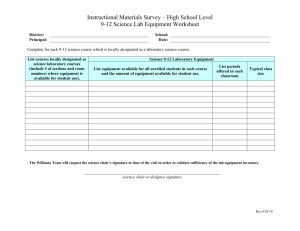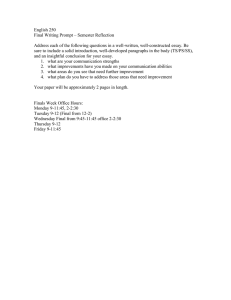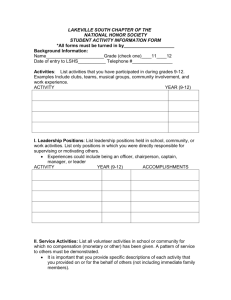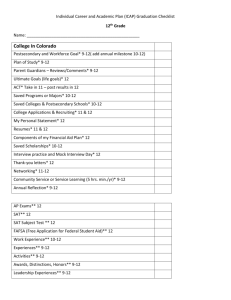Barren County High School Course Syllabus Course Title:
advertisement
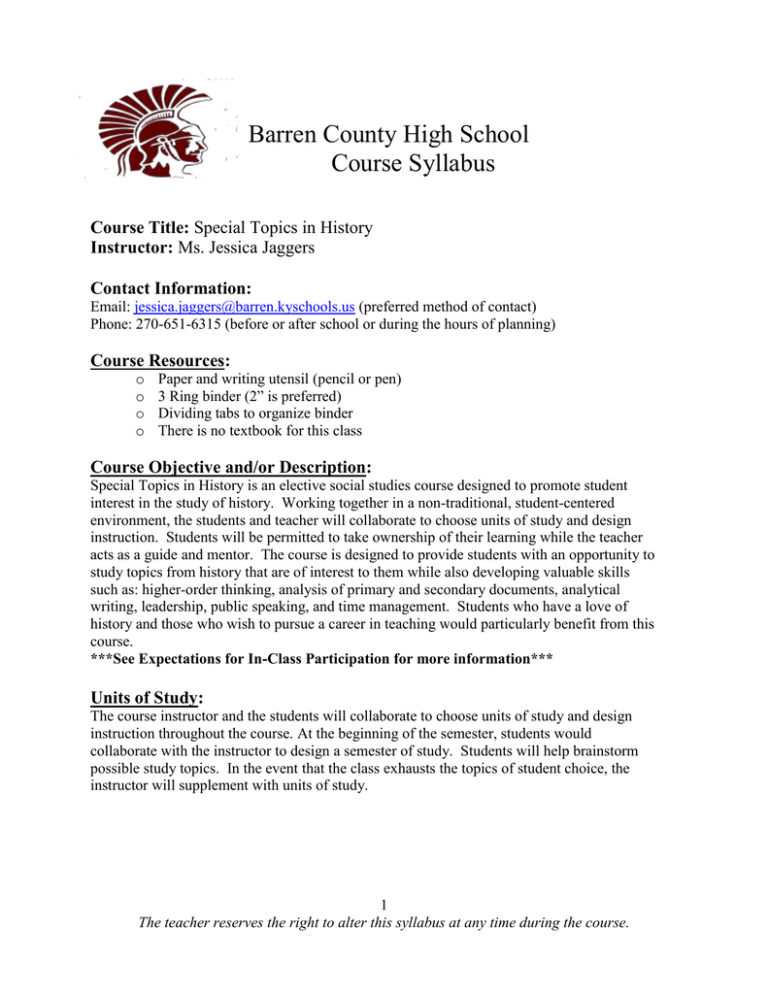
Barren County High School Course Syllabus Course Title: Special Topics in History Instructor: Ms. Jessica Jaggers Contact Information: Email: jessica.jaggers@barren.kyschools.us (preferred method of contact) Phone: 270-651-6315 (before or after school or during the hours of planning) Course Resources: o o o o Paper and writing utensil (pencil or pen) 3 Ring binder (2” is preferred) Dividing tabs to organize binder There is no textbook for this class Course Objective and/or Description: Special Topics in History is an elective social studies course designed to promote student interest in the study of history. Working together in a non-traditional, student-centered environment, the students and teacher will collaborate to choose units of study and design instruction. Students will be permitted to take ownership of their learning while the teacher acts as a guide and mentor. The course is designed to provide students with an opportunity to study topics from history that are of interest to them while also developing valuable skills such as: higher-order thinking, analysis of primary and secondary documents, analytical writing, leadership, public speaking, and time management. Students who have a love of history and those who wish to pursue a career in teaching would particularly benefit from this course. ***See Expectations for In-Class Participation for more information*** Units of Study: The course instructor and the students will collaborate to choose units of study and design instruction throughout the course. At the beginning of the semester, students would collaborate with the instructor to design a semester of study. Students will help brainstorm possible study topics. In the event that the class exhausts the topics of student choice, the instructor will supplement with units of study. 1 The teacher reserves the right to alter this syllabus at any time during the course. Standards and Curriculum Alignment: This course is aligned with standards outlined in the C3 Framework. o Dimension 1: Developing Questions and Planning Inquiries o o o o o D1.1.9-12: Explain how a question reflects an enduring issue in a field D1.2.9-12: Explain points of agreement and disagreement experts have about interpretations and applications of disciplinary concepts and ideas associated with a compelling question. D1.3.9-12: Explain points of agreement and disagreement experts have about interpretations and applications of disciplinary concepts and ideas associated with a supporting question. D1.4.9-12: Explain how supporting questions contribute to an inquiry and how, through engaging source work, new compelling and supporting questions emerge. D1.5.9-12: Determine the kinds of sources that will be helpful in answering compelling and supporting questions, taking into consideration multiple points of view represented in the sources, the types of sources available, and the potential uses of the sources. o Dimension 2: Applying Disciplinary Concepts and Tools o D2.His.1.9-12. Evaluate how historical events and developments were shaped by unique circumstances of o o o o o o o o o o o o o o o o time and place as well as broader historical contexts. D2.His.2.9-12. Analyze change and continuity in historical eras. D2.His.3.9-12. Use questions generated about individuals and groups to assess how the significance of their actions changes over time and is shaped by the historical context. D2.His.4.9-12. Analyze complex and interacting factors that influenced the perspectives of people during different historical eras. D2.His.5.9-12. Analyze how historical contexts shaped and continue to shape people’s perspectives. D2.His.6.9-12. Analyze the ways in which the perspectives of those writing history shaped the history that they produced. D2.His.7.9-12. Explain how the perspectives of people in the present shape interpretations of the past. D2.His.8.9-12. Analyze how current interpretations of the past are limited by the extent to which available historical sources represent perspectives of people at the time. D2.His.9.9-12. Analyze the relationship between historical sources and the secondary interpretations made from them. D2.His.10.9-12. Detect possible limitations in various kinds of historical evidence and differing secondary interpretations. D2.His.11.9-12. Critique the usefulness of historical sources for a specific historical inquiry based on their maker, date, place of origin, intended audience, and purpose. D2.His.12.9-12. Use questions generated about multiple historical sources to pursue further inquiry and investigate additional sources. D2.His.13.9-12. Critique the appropriateness of the historical sources used in a secondary interpretation. D2.His.14.9-12. Analyze multiple and complex causes and effects of events in the past. D2.His.15.9-12. Distinguish between long-term causes and triggering events in developing a historical argument. D2.His.16.9-12. Integrate evidence from multiple relevant historical sources and interpretations into a reasoned argument about the past. D2.His.17.9-12. Critique the central arguments in secondary works of history on related topics in multiple media in terms of their historical accuracy. o Dimension 3: Evaluating Sources and Using Evidence o D3.1.9-12. Gather relevant information from multiple sources representing a wide range of views while o o o using the origin, authority, structure, context, and corroborative value of the sources to guide the selection. D3.2.9-12. Evaluate the credibility of a source by examining how experts value the source. D3.3.9-12. Identify evidence that draws information directly and substantively from multiple sources to detect inconsistencies in evidence in order to revise or strengthen claims. D3.4.9-12. Refine claims and counterclaims attending to precision, significance, and knowledge conveyed through the claim while pointing out the strengths and limitations of both. 2 The teacher reserves the right to alter this syllabus at any time during the course. o Dimension 4: Communicating Conclusions and Taking Informed Action o D4.1.9-12. Construct arguments using precise and knowledgeable claims, with evidence from multiple o o o o sources, while acknowledging counterclaims and evidentiary weaknesses. D4.2.9-12. Construct explanations using sound reasoning, correct sequence (linear or non-linear), examples, and details with significant and pertinent information and data, while acknowledging the strengths and weaknesses of the explanation given its purpose (e.g., cause and effect, chronological, procedural, technical) D4.3.9-12. Present adaptations of arguments and explanations that feature evocative ideas and perspectives on issues and topics to reach a range of audiences and venues outside the classroom using print and oral technologies (e.g., posters, essays, letters, debates, speeches, reports, and maps) and digital technologies (e.g., Internet, social media, and digital documentary). D4.4.9-12. Critique the use of claims and evidence in arguments for credibility. D4.5.9-12. Critique the use of the reasoning, sequencing, and supporting details of explanations. Grading Policy: Grades for this course will be assigned using the school-approved grading scale: A= 100-90 % B= 89-80 % C= 79-70 % D= 69-60 % A failing grade will be recorded for students who earn an average of less than 60%. Expectations for In-Class Participation: This course is designed to promote student ownership of learning. The instructor will act as a guide and mentor while the majority of discussion and class leadership will be in the hands of the students. Students are expected to engage in meaningful participation every day. Failure to participate fully on a regular basis will reflect negatively in student grades. Writing Component: The Barren County High School writing plan requires that students in all classes complete an On-Demand writing prompt as well as a portfolio piece each semester. In addition to these two writing requirements, students will be expected to consistently use writing to demonstrate learning. Reading Component: Although there is no textbook for this class, students will be expected to engage in various types of reading. Students will read a variety of historic documents and become proficient at both primary and secondary document analysis. Tardy Policy: This is your warning; DO NOT BE LATE!!!! Students should report to class at the proper time. Students who are not in the classroom when the bell stops ringing, will be counted tardy. Students should also come to class prepared. Failure to report to class with the necessary materials may also result in the student being counted tardy. Attendance Policy: Students are responsible for making up work missed due to an excused absence or field trip. BCHS policy states that students will be given the same amount of days to make up work as they 3 The teacher reserves the right to alter this syllabus at any time during the course. missed. Students are encouraged to communicate with the course instructor regarding makeup times and procedures. *** Certain projects and assignments will be assigned in advance (ex: This Day in History). Students who are absent on the day of the assignment will be expected to complete the required activity on the NEXT day he/she returns to school. Because the activity was scheduled in advance, no extra time or consideration will be given to the student.*** Semester Test Policy: All students in all classes are required to take a semester exam and/or final exam. There are NO EXEMPTIONS to this policy. Cheating Policy: Cheating will not be tolerated! Students caught cheating or allowing other students to copy their work will receive zero for that particular assignment or activity. Parents/guardians will be contacted. Depending upon the severity of the case, students may also be referred to the school administration should further disciplinary action be needed. ***Copying another student’s work or allowing another student to copy your work IS cheating. If I catch you doing this, I will give all students who are involved a zero for the homework assignment. I also reserve the right to refer those students to the office for disciplinary action.*** Plagiarism / Academic Dishonesty Policy: Plagiarism and academic dishonesty are serious offenses. The academic work of a student is expected to be his/her own effort. Students must give the author(s) credit for any source material used. To represent ideas or interpretations taken from a source without giving credit is a flagrant act. To present a borrowed passage after having changed a few words, even if the source is cited, is also plagiarism. Students who commit any act of academic dishonesty will receive a failing grade in that portion of the course work. Acts of academic dishonesty will be reported to the administration. Classroom Rules: Be Respectful! (Student disrespect will NOT be tolerated.) -Be advised, I consider using your cell phone in class to be disrespectful. If I see it OR hear it, I will write you up and confiscate your cell phone. -I also view attempts at sleeping as disrespectful behavior. Do not even lay your head down on the desk. If I can’t see your eyes, I will assume that you are sleeping and write you up. Be Prompt and Prepared! -See tardy policy for more information on tardiness -Coming to class unprepared (ie. without homework, notebook, or pencil) may result in a write up. Follow ALL school policies and procedures! 4 The teacher reserves the right to alter this syllabus at any time during the course.
